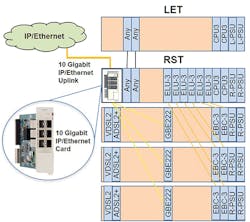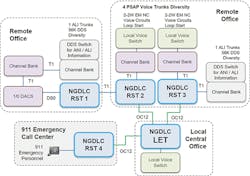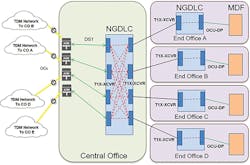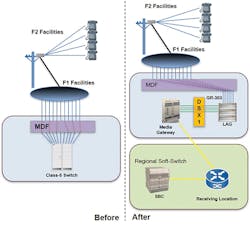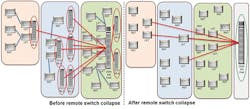Graceful Network Transformation for the Ultimate End-Game of Ethernet, IP, and Fiber Modernization —
As service providers transition their networks to an all-IP Ethernet infrastructure, they struggle with the challenges of these limited resources:
EQUIPMENT — There are limited choices for access gear that supports narrowband and broadband connectivity simultaneously. Many of the legacy platforms have been manufacturer discontinued, and face replacement parts shortage and ever-increasing failure rates. Even worse, by continuing to deliver lifeline POTS and other critical business services on these unsupported systems, service providers expose themselves to liabilities.
HUMAN — Network operators are experiencing a widening internal skill set gap — retirements are accelerating, and with them goes critical technical knowledge.
FINANCIAL — Service providers continue to do business during these lean financial times without additional revenues.
This all means that wireline network modernization projects have been delayed or even cancelled.
However, there is a way that network operators can take advantage of existing Next Generation Digital Loop Carrier (NGDLC) equipment to cost effectively modernize the access network from narrowband analog/TDM to broadband optical/IP — without abandoning narrowband revenues. Network transformation projects come in a wide range, but existing multi-service access platforms are a great choice for 7 modernization projects such as:
• Moving networks from copper to optical plant
• Migrating from TDM to Ethernet connectivity
• Support of narrowband while delivering broadband services
• 911 redundancy and diversity for 911 call center access
• 1/0 digital cross-connect system (DCS) support
• TDM Switch replacement to modern softswitches
• Collapsing remote switches to host switches
Project 1: Moving networks from copper to optical plant
Service providers still require networking gear to support existing copper- and fiber-based outside plant. And even in the outside plant where there is fiber, there is still the need to support a variety of fiber-based options including ATM and SONET. Unfortunately, much of the network equipment that has traditionally supported these interfaces does not exist anymore.
However, you can still use existing NGDLC to support your copper connectivity and provide high-capacity transport options including Ethernet 10/100Mbps, 1Gbps and 10Gbps optical interfaces, plus ATM and SONET fiber-based connectivity choices.
Project #2: Migrating from TDM to Ethernet connectivity
Deploying contemporary Ethernet-centric services from a service provider’s embedded base of access equipment is challenging enough; but modernizing a traditional digital loop carrier system to support fiber-based and Ethernet connectivity, without cannibalizing existing revenue from copper-based legacy services, is nearly impossible. What network operators need is a fiber-fed digital loop carrier system that supports a wide variety of service, transport, and network connectivity, including copper, optical, Ethernet, SONET, and even ATM.
InvisiLight® Solution for Deploying Fiber
April 2, 2022Go to Market Faster. Speed up Network Deployment
April 2, 2022Episode 10: Fiber Optic Closure Specs Explained…
April 1, 2022Food for Thought from Our 2022 ICT Visionaries
April 1, 2022Here is where existing NGDLCs truly shine in supporting modern Ethernet transport and services end-to-end. This includes 10Gbps and 1Gbps Ethernet interfaces toward the core network, across interterminal transport and optional for 10/100 Ethernet drops to end users. These NGDLCs can support Ethernet interfaces simultaneously with legacy connectivity, like DS1, DS3, OC3, and OC12. (See Figure 1.)
Figure 1. Migrating from TDM to Ethernet connectivity.
Project #3: Support of narrowband while delivering broadband services
Service provider networks are evolving to take advantage of new technologies that support users’ ever-increasing demands for bandwidth. But change does not happen overnight, and legacy telecom services continue to remain an important part of network operations (e.g., P-Phone, DID, DOD, DDS, 2-wire E&M, 4-wire E&M, ISDN, etc.). In many cases, both large and small businesses have made big investments in legacy equipment and related processes. When the companies expand to new locations, or add capacity, it often makes sense to continue deploying embedded technologies. In fact, in some cases, government tariffs may regulate that service providers offer services that fall into the legacy category.
NGDLCs are well-suited to meet the demands of all services in today’s networks with a clear path to evolving services. It is the service provider’s best choice for delivering all legacy services while simultaneously providing emerging services. For example, there are NGDLCs that continue to add features and functionality to support ADSL, VDSL, G-PON, XGS-PON, and NG-PON2, all from the same access platform that still support legacy services.
Project #4: 911 redundancy and diversity for 911 call center access
The FCC has imposed new network reliability requirements for Public-Safety Answering Point (PSAP) call centers responsible for answering calls for emergency services. They have done this to improve the resiliency of 911 networks. To meet these federal requirements, network operators are adding equipment redundancy and route diversity to central and remote offices where voice switches, Digital Data Service (DDS), and databases exist.
Many service providers are turning to existing NGDLC equipment to ensure proper redundancy and diversity, and these NGDLCs are already tested, approved, installed, and operationalized with most North American 911 service providers. This allows for a smart, easy, and cost-effective, access solution to satisfy the goals of the 911 PSAP redundancy and diversity architecture with the existing NGDLC footprint. (See Figure 2.)
Figure 2. 911 redundancy and diversity for 911 call center access.
Project #5: 1/0 digital cross-connect system (DCS) support
DS0 specials will be around for some time. Complicating matters is the fact that network operators still have large customers, like the federal government, who are not willing or ready to give up their ISDN or P-Phone services. The 1/0 DCS and D4 channel back assemblies (CBA), have historically been the workhorse for packing and grooming DS0 specials from A to Z locations. Now much of this legacy equipment is underutilized and manufacturer discontinued. It is best for service providers to de-load and remove them from the central office.
This challenging situation can be remedied by using existing NGDLC systems that are already operationalized and fully supported as the replacement vehicle. The NGDLC can be used to replace the 1/0 DCS, and pack and groom the DS0s into DS1s. The NGDLC can also act like a D4 CBA and Mux to pack and send DS0s directly to the end office. This all can be accomplished at a central office, remote office, remote cabinet, or customer premises. (See Figure 3.)
Figure 3. 1/0 digital cross-connect system (DCS) support.
Project #6: TDM Switch replacement to modern softswitches
With the sunset of TDM switches looming, migration to a packet-based regional softswitch is the desired goal for most service providers. However, 3rd party media gateways are expensive, and the internal deployment requirement and project management impact to network operators can be challenging. However, these softswitches do not support all the special services and business services that the TDM switch provides. Many of these services represent meaningful revenue streams, and some are mandated by regulation. This means service providers cannot simply remove all the TDM switches from their network.
This is where an embedded NGDLC, that is already operationalized by the service providers, can be leveraged to cost effectively distribute 100% of the TDM services over TDM or IP/Ethernet transport networks. NGDLC can be used for Universal TR-57, TR-008 and GR-303 TDM switch replacement, without giving up the services and revenue associated with them. This allows reduced OpEx, improved service reliability, and permanently improved cost structures. (See Figure 4.)
Figure 4. TDM Switch replacement to modern softswitches.
Project #7: Collapsing remote to host switches
The previous section dealt with the replacement of a TDM switch to softswitch and how an NGDLC platform helps that transition. There are also instances where network operators want to collapse a stand-alone TDM switch into a different stand-alone TDM switch (i.e., TDM to TDM). This would be done if the remote switch is in trouble (running simplex), very lightly loaded and "bone-yard pick" for spare parts for the remaining network.
Once again, a NGDLC can be used to deliver all the services and functionality of the TDM switch over TDM or IP/Ethernet transport networks with less financial and resource impact on the service provider. This capability will allow rehoming of services to a reduced number of TDM switches so that most can be removed from the network. The NGDLC can also deliver IP DSL and Ethernet services, allowing for continuing network and service evolution long after the last TDM switch is finally retired. (See Figure 5.)
Figure 5. Collapsing remote switches to host switches.
Like this Article?
Subscribe to ISE magazine and start receiving your FREE monthly copy today!
Improve Network Reliability, Reduce OpEx, and Preserve Revenues
NGDLC platforms, like the Tellabs® 1000 Multiservice Access Platform (MSAP), can be used for network transformation projects by all service providers for the projects described above. Simply use the multiservice access platform, narrowband cards, broadband xDSL cards, G-PON, 10G XGS-PON, 1G or 10G Ethernet cards, to upgrade and expand your existing networks that are already operationalized — without sacrificing revenue for legacy services.
About the Author






